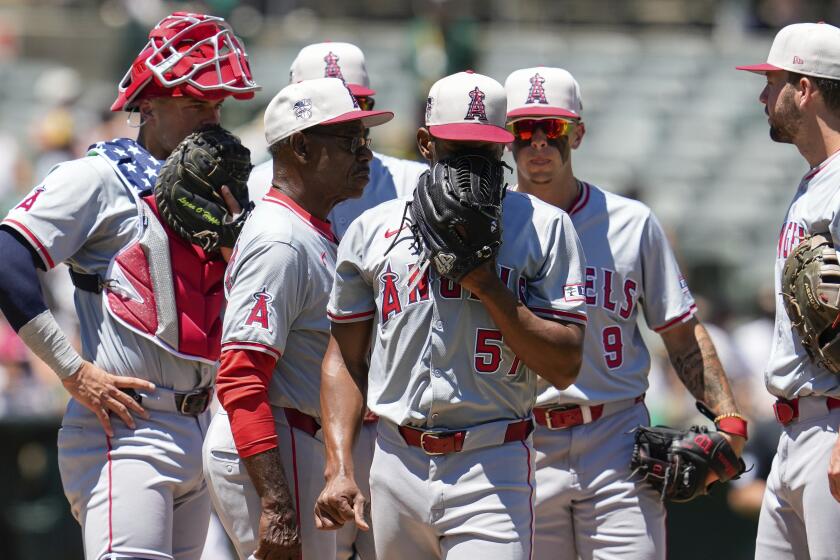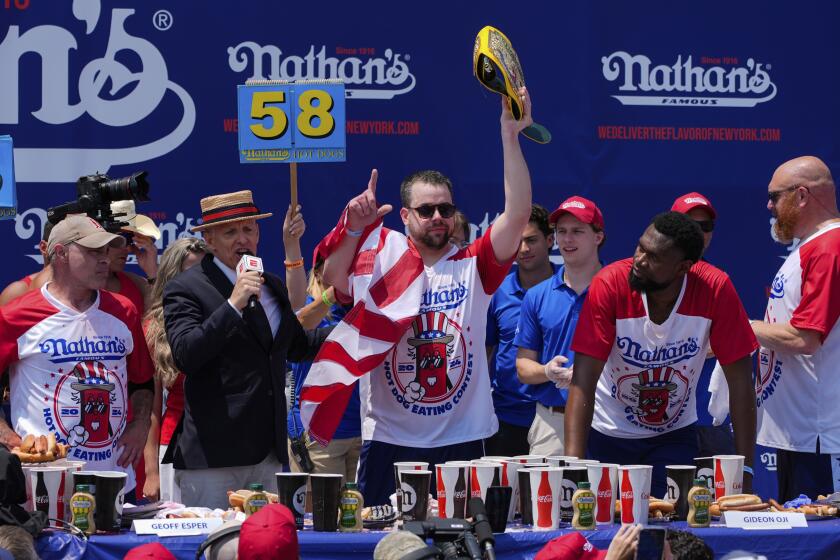BUCKING TRADITION : By Taking Chances, Fiesta Bowl Brings in New Year With Success
The Fiesta Bowl acquired its ambition later in life. When it started, back in 1971, nobody had much in mind except finding a place for the hometown team to play. In fact, many trace the bowl’s origins to 1968, when hated Arizona was picked ahead of Arizona State to play in the Sun Bowl and the university president, Homer Durham, bitterly suggested: “Maybe we should start our own bowl.”
That was as big as anybody thought back then. And when they finally did start a bowl, there was no noticeable improvement on the original ambition. Arizona State played in 5 of the first 7 Fiesta Bowls. It was strictly a civic enterprise, college football’s block party, and a pretty small block at that.
But look at it now. With this season’s game between No. 1-ranked Notre Dame and No. 3 West Virginia, the Fiesta Bowl has landed the national championship game in 2 of the last 3 years. It’s a big boy now.
It pays teams rates comparable to the four traditional bowls. It attracts comparable TV audiences. NBC’s prime-time broadcast of the 1987 Fiesta Bowl game remains the record audience for a bowl. And teams listen when the men in the bright yellow blazers come calling.
In short, it is now considered among the Rose, Cotton, Sugar and Orange, the traditional sugar daddies in college football. After only 18 years, it certainly is not in their league in terms of tradition. But in that short time the Fiesta Bowl has become every bit as important.
“They’re right there,” said Athletic Director Jim Tarman of Penn State, whose team has played in 4 Fiesta Bowls. “They’re every bit as big as the other ones.”
Traditionally there have been the four New Year’s Day bowls, the elite, with a large underclass struggling beneath them. Most of these bowls, chamber of commerce get-togethers really, compete for what ranked--or even winning--teams are available, offering various levels of recompense, from $500,000 to $1 million per team; exposure, Raycom to ESPN, and hospitality.
For a long time, the Fiesta was part of this swelling underclass, another minor bowl struggling for National Collegiate Athletic Assn. certification and a decent matchup and a good crowd and a few tourist dollars on the side. Just 10 years ago, the Fiesta was lumped with the Holiday, Gator and Liberty bowls, just a notch above the Independence, Citrus and Peach.
At that time, the Rose Bowl, which now pays $6.1 million, was paying teams $2-plus million, the Cotton $1.5 million. The Fiesta dangled a pay-out of $342,000 a team.
This season, the Fiesta Bowl pay-out of $2.5 million is the equal of the Cotton’s and not far down from the Sugar’s and Orange’s at $2.75 and $2.8 million, respectively. And it has long since doubled that of its presumed peers.
The Fiesta Bowl has become enough of an attraction that NBC, which has broadcast the Fiesta the last 10 years, was willing to let its expensive Rose Bowl contract go to ABC and challenge its old bread-and-butter game. In 1989, for the first time, the Fiesta will go head to head with “the granddaddy of them all” and few doubt who the ratings winner will be.
How did this happen? How did the Fiesta cut itself from the herd of minor league bowls, a regional attraction at best, and come to threaten the big four, a national presence?
With luck and the kind of fresh ideas that may only be possible in a new city with a new institution.
The luck came through when the Fiesta Bowl needed it most, in the beginning when none of the organizers knew what they were doing. There had been other halfhearted attempts at beginning a bowl, “disastrous attempts,” recalls Tom Fridena, later a Fiesta Bowl president, who was on the scene at first as a volunteer. “Salad and Copper, whatever. Never got off the ground. Tried to start something called the Goulash Bowl.”
The Fiesta Bowl didn’t have much more promise, except that Arizona State, the point of the whole thing, happened to have a pretty good team at that time.
To get its NCAA certification, the Fiesta Bowl came to an agreement with the Western Athletic Conference. The Fiesta people were not told to do so, but they believed it was an unspoken condition. Anyway, that was no problem, as long as Arizona State won the conference title, which it often did.
Said Executive Director Bruce Skinner: “The fact that ASU played in 5 of the first 7 had something to do with where we are today. One, it was easy to sell tickets, which is often a problem with a young bowl. Two, ASU was getting ranked in the top 10, giving us the kind of team the younger bowls never have. We started out having good respectable teams, and good ticket sales.
“A lot of the younger bowls are plagued by having to invite teams because they’ll sell tickets. So compared to other start-up bowls, ours was easy.”
Later, as a bowl with no conference affiliation, the Fiesta was in a position to attract the powerful also-rans, teams that didn’t get to the Orange Bowl but were still big-name enough to sell a few tickets and please a network. It was a combination of this independence, and a little luck, that gave the Fiesta Bowl another push toward the big time.
“In 1975, we got Nebraska,” Skinner said. “Our first good invited team.”
That was partly luck.
“They kinda got locked out, to tell you the truth,” Skinner said. “All of a sudden, the Fiesta Bowl was the only place to go. Plus, we had already had Missouri and Oklahoma State (of the Big Eight) and they had a great time.”
So the Fiesta Bowl hospitality, the resort atmosphere--December temperatures average 72 degrees--and family ambiance, became part of the Big Eight word of mouth.
“The next year,” Skinner said, “Oklahoma called us.”
This even though the Fiesta Bowl went to a Christmas Day game in 1976.
Recalled Fridena: “We finally got on CBS but with the opportunity to go on Christmas Day. Now, that is a terrible, terrible thing. A hell of a risk. We got better TV money and higher ratings, but also resentment from the fans.”
The bowl weathered whatever resentment there was but built up national awareness with the network TV contract and continued to pick off desperate and disappointed powers to showcase. It was a risk that paid off with even bigger money and increased exposure. In 1977, another turning point, Penn State came.
Penn State Athletic Director Jim Tarman said: “It was kind of an accident. We thought we were headed for the Orange Bowl. All of a sudden, Arkansas is in the Orange Bowl. We had a couple of opportunities to play in so-called lesser bowls, not that we had a lot of choices. But we had heard from some people that (the Fiesta Bowl) was a fun time.”
Penn State went, liked it.
“We talked it up,” Tarman said.
Ohio State went a few years later, lost to Penn State but told Tarman, just the same, “You guys were right.”
The bowl continued to grow. Its respectability was ratcheted upward again after the 1981 season, when USC and Penn State landed there for its first New Year’s Day game.
That was another risk, moving into Big Four country. Skinner had heard the year before that the Sugar Bowl was moving to night, leaving the Cotton Bowl unopposed in the daytime slot.
“We didn’t know if we could make it,” Fridena said. “Who ever heard of a little pipsqueak bowl going up against a major bowl like the Cotton.”
But Phoenix bowl officials knew there were bowl games and there were New Year’s Day bowl games. There was a risk of getting crushed by the Cotton, which had been in that slot forever. But there was a chance to build even more awareness and, of course, increase its pay-out with bigger TV money.
Attendance at Sun Devil Stadium jumped to 71,000 for that game and the teams walked away with $637,000 apiece.
Through all this, and what followed, the Fiesta Bowl was guided by an attitude of “We can do this different next year.”
Said Skinner: “So many nonprofit organizations are plagued by ‘Let’s see if we can do it as good as last year.’ An attitude develops. But it’s much easier to come to Phoenix and do new things. We have a lot of corporate headquarters here and the people often remark how easy it is to present new ideas here.”
Skinner and his team soon had another new idea. They were running a nice little bowl, all right, but they still weren’t a real threat to the big guys. What to do?
“We were strung out on money,” Fridena said. “We needed money to get the good teams but it was a chicken-and-egg-type thing.”
The Fiesta Bowl pay-out, though increased, was nowhere near the $1-million bids the top four were handing out at that time, because they needed the good teams to get the big money.
“There was no way to get more TV money or more seats,” Fridena said. “We couldn’t raise ticket prices. So we said, let’s see if we can get a corporate sponsor.”
Sunkist, which had begun its Fiesta Bowl association by providing juice, coffee and doughnuts for the first media breakfast, was interested. The citrus co-op had no advertising budget to speak of and here was a way to take hold of an entire event.
So, the Fiesta Bowl became the Sunkist Fiesta Bowl, a sellout that was widely noted, and remarked upon, by the traditional bowls. Prostitution was a word often heard in subsequent discussions.
Still, with financial backing, the bowl was able to offer comparable pay-outs when a game between two top-ranked independents became available--Penn State vs. Miami, neither of which was tied by a conference or bowl affiliation.
These two free-lancers had been entertained in Tempe before but this time they would need more than hospitality. The Fiesta Bowl, able to stage this game for the national championship, whereas the traditional bowls could not, came up with $2.4 million a team by moving it to New Year’s Night and giving NBC a prime-time telecast.
The other bowls howled at this interloper. It was wrecking traditions by the minute. In time, though, they cooled, realizing that two top-ranked independent teams by year’s end was a generational event.
Said the Rose Bowl’s Jack French: “Chances of it ever happening again are pretty slim.”
In the time since then, a couple of things have happened. Noticeably, even the major bowls began copying the Fiesta. The Sugar Bowl is now preceded by USG&F; and the Cotton is called the Mobil Cotton Bowl. It is believed that the Orange Bowl will announce a title sponsor after its game.
Only the Rose Bowl, with its monster TV contract and its huge sellouts, remains above the fray. So much for prostitution.
The second thing is that the Fiesta Bowl decided to take another chance. When NBC got out of its contract with the Rose Bowl, it decided to put the Fiesta opposite. The Fiesta folks weren’t sure of that. They had strong ties with the Pacific 10 Conference and didn’t want their rivalry with the Rose Bowl to be anything but friendly.
Fridena said: “We were in a terrible, terrible situation. It was a bloody, bloody board meeting as to whether we take the money and attempt to go up against the Rose Bowl.”
They decided to take a chance.
What happens now is that slim chance French had discussed 2 years earlier. Independents Notre Dame and West Virginia materialized for another national championship game in the Fiesta Bowl.
French, of the Rose Bowl, is unworried. The Rose Bowl is never worried and no wonder. It has an $11-million-plus TV contract and offers enough to its Pac-10 and Big Ten entries--$6.1 million--that nobody involved so much as makes a peep. And it gets the ratings year in and year out, even though it hasn’t produced a No. 1 team out of this game since USC in 1979.
“We’re totally different,” French said. “I hope we’re not complacent but what we do is preserve a sense of tradition.”
They can afford to. French thinks a Rose Bowl is the best game of the year, the only exception being a national championship such as the Fiesta has staged. And, in fact, last year’s Rose Bowl, Michigan State vs. USC, drew a 16.5 rating, second to the Orange Bowl’s version of a national championship between Miami and Oklahoma, 20.8.
“The Fiesta had an 8 rating (8.7 with Florida State and Nebraska),” French said. “In recent years, they’ve had traditionally low ratings. If it’s not a national championship or a Rose Bowl, it’s not a great rating.”
French is not predicting that the Rose Bowl will blow the Fiesta away this season.
But he is predicting it’s not going to be a problem for all time.
“They’ve had national championship games twice,” he said. “That kind of record is not overwhelming.”
The Fiesta Bowl is not putting all its money on national championship games. It began as a forum for teams in the West and it would like to remain so, when it has to. A Pac-10 runner-up would be most welcome some years.
But the Pac-10 and the Big Ten, very mindful of the Rose Bowl’s wishes, won’t allow any member teams to play in bowls that compete directly with the Rose Bowl.
The Rose Bowl doesn’t insist on this condition but, French said: “They (the Pac-10) know our feelings on this.”
The Pac-10 commissioner, Tom Hansen, said that his conference has made a pledge to the Tournament of Roses and ABC to keep that rule intact.
And the rule is necessary, he said, because “NBC deliberately did that to try and hurt the Rose Bowl. They felt that bitter about losing the Rose Bowl.”
Of course, the Fiesta Bowl is always thinking ahead, always innovating and it hardly pays to underestimate those folks. It’s possible a Pac-10 team never will play in the Fiesta Bowl, but the Phoenix folks would surely love to repair relations, perhaps for that day when the best they can do is a strong Pac-10 runner-up.
It could be then, as Tom Hansen says, nothing more than “delicious irony.” But it’s certainly interesting that Hansen’s daughter, Sarah, was named the Fiesta Bowl Queen this year.
However far the Fiesta Bowl will go, there is no arguing that it has come a long way.
“What started out as a little bowl for some teams from the West and and a chance to have some excitement that time of year is now a 56-event, statewide festival and is fun,” Fridena said. “They say $25 million in cash plopped into town (last year) but money be damned, this is fun.”
More to Read
Get our high school sports newsletter
Prep Rally is devoted to the SoCal high school sports experience, bringing you scores, stories and a behind-the-scenes look at what makes prep sports so popular.
You may occasionally receive promotional content from the Los Angeles Times.






